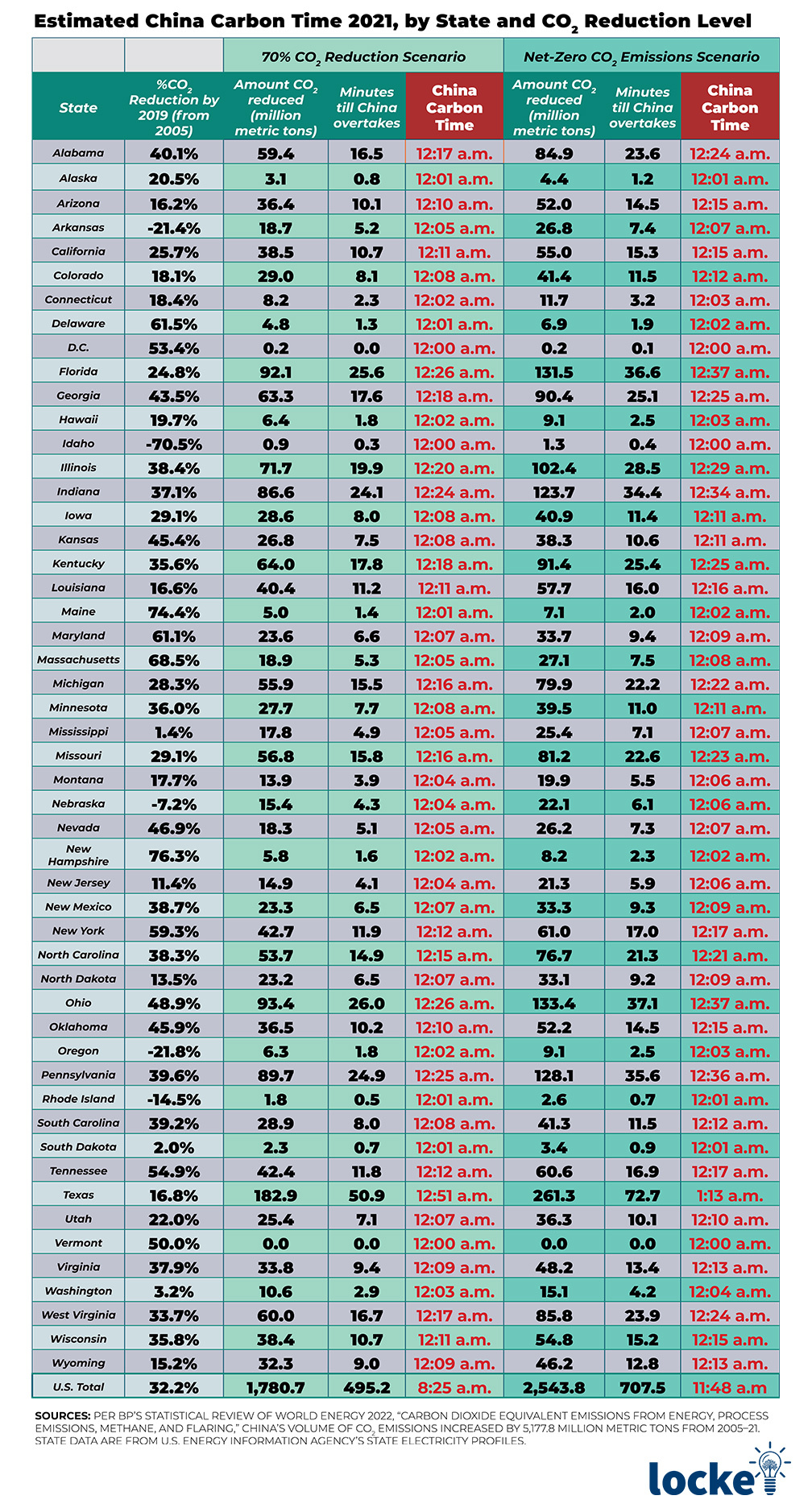- The U.S. is leading the world in cutting CO2 emissions even as China keeps increasing theirs, but environmental activists, politicians, and renewable energy producers are pushing the states to adopt enormously expensive emissions-reduction goals
- This brief asks how much of China’s increase in emissions could states conceivably offset, and it uses a metric of minutes in the day to help illustrate the problem
- “China Carbon Time” would arrive just minutes into the new day, shortly after the clock finishes striking midnight for most states
Since 2005, the U.S. has led the world in the volume of CO2 emissions reduced, thanks to market forces, not government mandates. Nevertheless, environmental activists, certain public officials and political leaders, and renewable energy producers have pushed a goal of mandating reductions of CO2 emissions in every state from electricity generation by 70 percent (from where they were in 2005) on up to “carbon neutrality.” Achieving those goals would create enormous expenses on people as taxpayers and ratepayers.
They would justify these massive costs out of the dubious belief that greater emissions reductions would in fact mitigate predicted climate change. In the meantime, China has increased the volume of its CO2 emissions since 2005 by a staggering 5,177.8 million metric tons and shows no sign of slowing down.
Regardless of their actual impact on global climate, CO2 emissions are fungible. Emissions from any particular area mix across the earth’s troposphere. Any “reward” from decreased emissions is not exclusive to the “virtuous” place, nor is any “penalty” from increased emissions localized to the “offending” area.
So the question asked here is simply this: How much of China’s increase in CO2 emissions could each state conceivably offset with a 70 percent reduction or more in its CO2 emissions from electricity generation?
To put the numbers in context, this exercise looks at China’s increase in emissions in terms of minutes in a full day (1,400). China’s nearly 5.2 billion metric tons of increased CO2 emissions since 2005 equate to roughly 3.55 million tons per minute of this hypothetical day. If the “day” started out with your state’s 70 percent reduction in CO2 emissions counterbalancing China’s increase, minute by minute, how long would it take before China’s much, much larger volume of increased emissions outlasted the offset by your state’s decreased emissions? How long would it take under your state’s “carbon neutral” (100 percent reduction) scenario?
In other words, when would “China Carbon Time” start for your state? It’s the time when there’s nothing more your state could do to offset China’s increase in CO2 emissions.
States can impoverish and endanger their own citizens, but they aren’t going to affect the world’s climate one bit.
The following chart lists each state by the volume of CO2 reduction it would need to reach the 70 percent goal, what percent reduction it had achieved by 2019, and when its China Carbon Time would be as of 2021. It also does the same for the “carbon neutral” (or “net zero”) goal. State data for CO2 emissions from electricity generation are from the U.S. Energy Information Agency’s state electricity profiles, while data concerning China’s CO2 emissions are from BP’s Statistical Review of World Energy 2022.

As you can see, for most states the clocks would have barely finished striking midnight before China had already overwhelmed their level-best CO2 emissions reductions. For the rest, it’s mere minutes into the day. Only the largest states can even push past the first 15 minutes (North Carolina is right at 12:15 a.m.).
All combined, a 70 percent reduction in electricity emissions across the U.S. would yield a China Carbon Time of 8:15 in the morning. It would still be morning — 11:48 a.m. — even if the U.S. eliminated all CO2 emissions from electricity generation.
A deeper look into the matter — some troubling implications
China’s CO2 emissions are still on the increase
Thinking further on the matter yields several uncomfortable facts. The first is that China has not even come close to hitting its ceiling on CO2 emissions:
Nor does China’s rapid expansion of coal-fired electricity show any sign of slowing. The nation added 38.4 gigawatts (GW) of new coal-fired electricity in 2020, announced 43 new coal-fired plants and 18 new blast furnace projects just in the first half of 2021, and expects to increase coal-fired electricity this year by 300 million tons.
The longer past 2021 we go, the earlier a state’s China Carbon Time would arrive.
The amount of CO2 each state can reduce is limited
The second is related: while China’s future CO2 increases still have no conceivable limit, the amount of CO2 reduction needed by a particular state to achieve a 70 percent reduction from its 2005 level is a known number. That amount can get no bigger, and obviously neither could the “net zero” (100 percent reduction) amount.
The already limited proportion of China’s additional CO2 emissions that each state can offset is getting smaller
The implication is this: the longer it takes to reduce a state’s CO2 emissions by 70 percent, the less of China’s still-increasing volume of CO2 emissions that state can offset. China Carbon Time can only arrive sooner, no matter how much we spend fighting it — and how many working electricity plants we destroy in the futile pursuit. States can impoverish and endanger their own citizens, but they aren’t going to affect the world’s climate one bit.
Most of the rest of the world’s CO2 emissions are also still increasing
Finally, while China is the worst nation in terms of adding CO2 emissions since 2005, it is by no means the only nation to continue increasing CO2 emissions. As discussed in a previous research brief,
Emissions across Africa (351.4 million tons), the Middle East (956.0), and South and Central America (148.3) have all increased. … India’s CO2 emissions increased by 1,478.5 million tons.
Forcing CO2 reductions in the U.S. is all cost, no conceivable benefit to Americans
The U.S. has reduced its volume of CO2 emissions by more than any other nation in the world. Any costs that the U.S. or individual states impose on taxpayers and ratepayers here to reduce CO2 emissions from electricity generation further would be enormous wastes of other people’s money and resources. They’ll be completely obliterated by ongoing increases in China and elsewhere.
The next brief will discuss the implications of this exercise for North Carolina.


